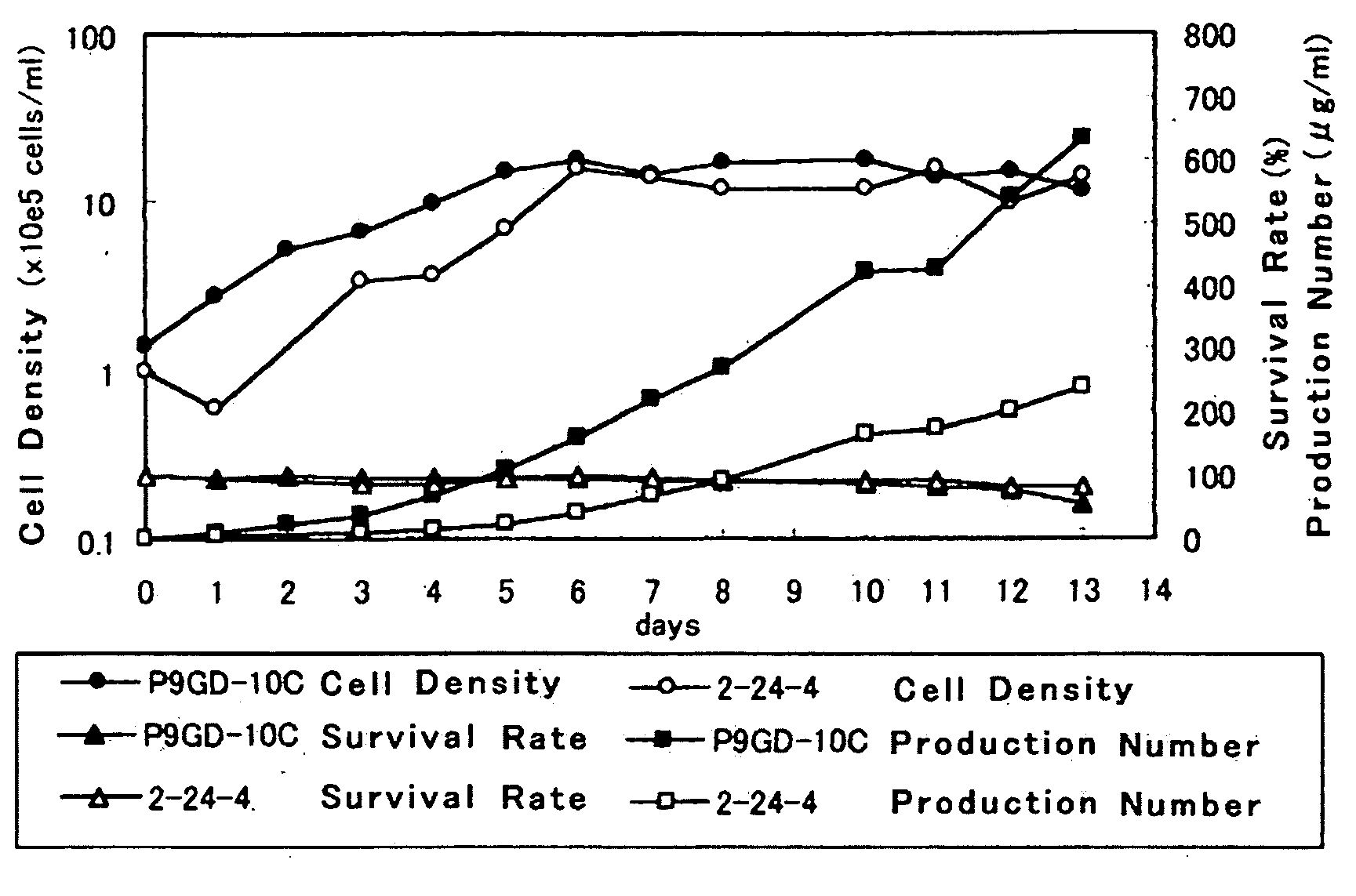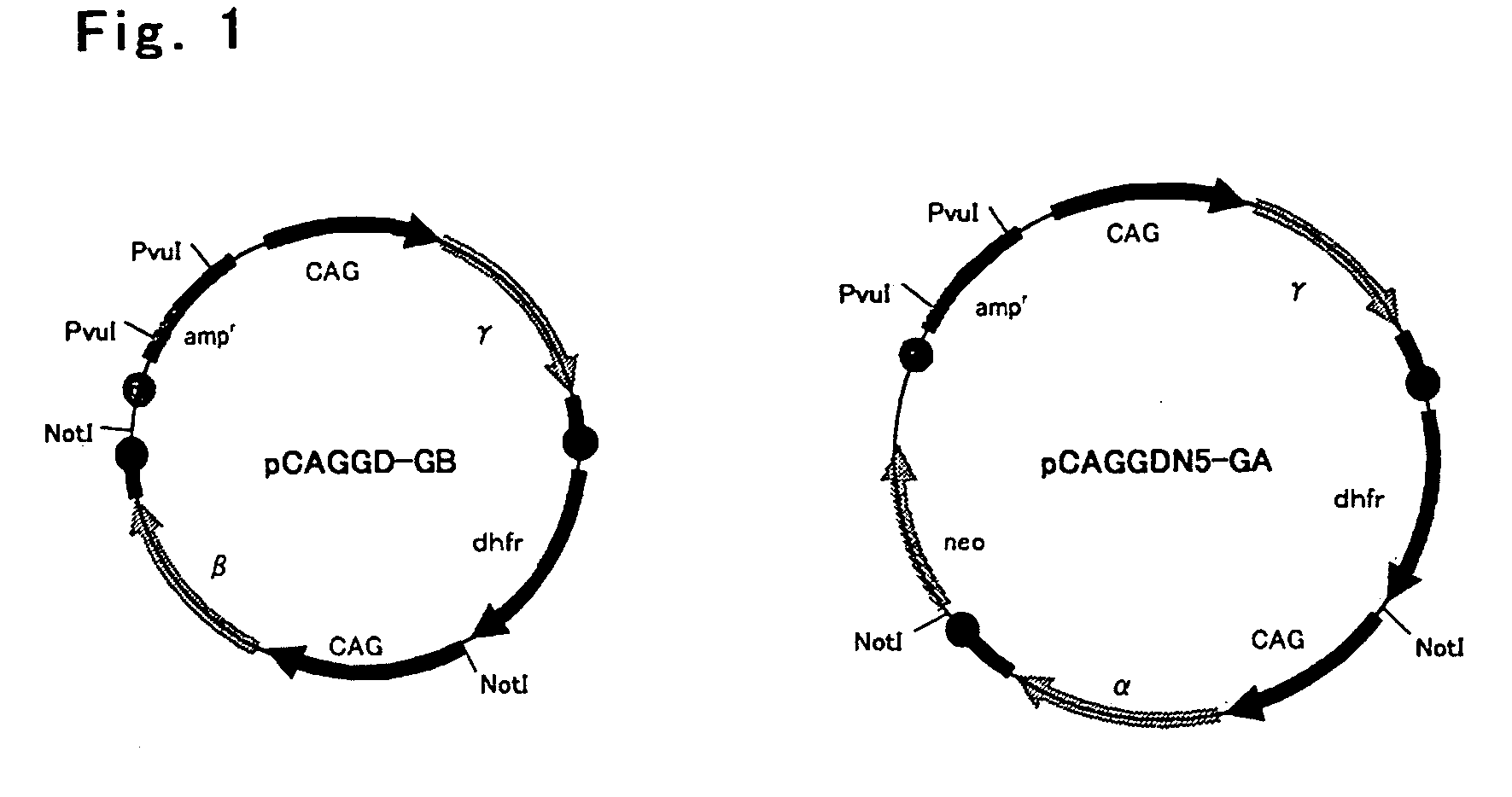Process For Producing Recombinant Fibrinogen Highly Producing Cell and Highly Producing Cell
a technology of fibrinogen and high-producing cells, which is applied in the field of high-producing cell and high-producing cell production processes, can solve the problems of difficult implementation from a production cost perspective, and achieve the effects of large production amount, large supply amount, and increased production amoun
- Summary
- Abstract
- Description
- Claims
- Application Information
AI Technical Summary
Benefits of technology
Problems solved by technology
Method used
Image
Examples
example 1
Isolation of Fibrinogen Gene
[0049]For a human fibrinogen gene, as a primer, each two primers consisting of a Kozak sequence and an added necessary enzyme site for an α chain, a β chain, and a γ chain were prepared (SEQ ID NOs: 1 to 6), and a PCR reaction was performed using Advantage HF-2 PCR Kit (BD Bioscience) and employing Human Liver Marathon-Ready cDNA (BD Bioscience) as a template according to a protocol of the kit. As a result, a band of PCR amplification was detected in each of an α chain, a β chain, and a γ chain. Since its size was coincident with each size of the known α chain, β chain, and γ chain, cDNA genes, these genes were cloned (pFbgA, pFbgB, pFbgG, respectively) using a TA cloning kit (Invitrogen), and its nucleotide sequence was determined using ABI PRISM310 Genetic Analyzer (PE Biosystems). As a result, FbgA, FbgB and FbgG genes shown in SEQ ID NOs: 7 to 9, respectively, were obtained.
example 2
Construction of Fibrinogen Gene Expression Vector
[0050]A fibrinogen β chain and γ chain gene expression vector pCAGGD-GB, and a fibrinogen α chain and γ chain gene expression vector pCAGGDN5-GA used in the present Example were constructed as follows: For pCAGGD-GB, first, pCAGG-S1 dhfr (WO 03 / 004641) was digested with BamHI, blunt-ended with a T4 DNA polymerase, and ligated using a phosphorylation NotI linker (TAKARA SHUZOU Co., Ltd.) to construct pCAGG-S1 dhfrN, and into the SalI site thereof was incorporated a SalI fragment of a FbgG gene derived from pFbgG to construct pCAGGD-G. Further, pCAGG(Xho) (WO 03 / 004641) was digested with SalI, blunt-ended with a T4 DNA polymerase, and ligated using a phosphorylation NotI linker (TAKARA SHUZOU CO., Ltd.) to construct pCAGG (Xho) N, a XbaI-BamHI fragment containing SalI of pCAGG-S1 (WO 03 / 004641) was incorporated into a XbaI-BamHI site of this plasmid, a BamHI site of the resulting plasmid was digested, blunt-ended with a T4 DNA polymeras...
example 3
Preparation of Recombinant Fibrinogen Expressing Cell
Introduction of Expression Vector Into Cell, Gene Amplification, Cloning
[0052]Using fibrinogen expression plasmids pCAGGD-GB and pCAGGDN5-GA constructed in Example 2, a CHO DG44 (Urlaub G et al., Somatic cells. Mol. Genet., 12, 555 (1986), hereinafter, CHO) cell was transformed by the following method. On a day before transformation, a CHO cell was seeded on a 6 well plate at a cell density of 1 to 0.5×105 cells / 2 ml / well using a YMM medium (nucleic acid-free MEM alpha medium enriched in amino acid and vitamin containing insulin, transferrin, ethanolamine and sodium selenite) containing 10% bovine fetal serum (FCS, manufactured by GIBCO-BRL). After culturing at 37° C. with a 5% CO2 culturing device overnight, transfection was performed according to each protocol using an introduction DNA obtained by mixing each equal amount of fibrinogen expression plasmids pCAGGD-GB and pCAGGDN5-GA, and digesting and linearizing the mixture with ...
PUM
| Property | Measurement | Unit |
|---|---|---|
| concentration | aaaaa | aaaaa |
| concentration | aaaaa | aaaaa |
| constant current | aaaaa | aaaaa |
Abstract
Description
Claims
Application Information
 Login to View More
Login to View More - R&D
- Intellectual Property
- Life Sciences
- Materials
- Tech Scout
- Unparalleled Data Quality
- Higher Quality Content
- 60% Fewer Hallucinations
Browse by: Latest US Patents, China's latest patents, Technical Efficacy Thesaurus, Application Domain, Technology Topic, Popular Technical Reports.
© 2025 PatSnap. All rights reserved.Legal|Privacy policy|Modern Slavery Act Transparency Statement|Sitemap|About US| Contact US: help@patsnap.com



